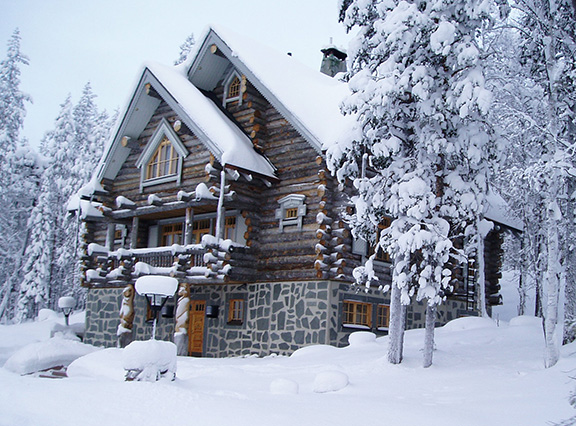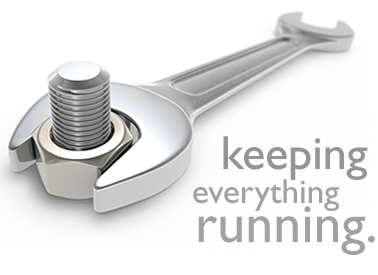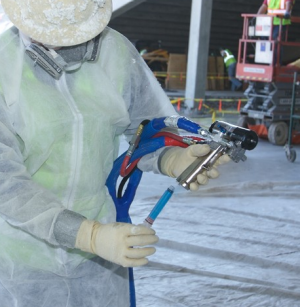Fall has officially fallen in most of the continental 48 and all you SPF contractors know what that means. It’s time to fire up the “hot room” and dust off the space heaters you put away last spring. Now is the time to brush up on some cold-weather spray tips so you don’t lose money on those “summer” jobs that are just now ready for you. Here’s a short list of my top three most important cold-weather techniques to keep your profits up as temps go down.
Drum Temperature, Drum Temperature, Drum Temperature!
We’ve all been there… Monday morning you start a four-set OC.5 job. It’s a perfect 75 ℉. You finish the day and park the rig outside because the temps are predicted to hold steady. But overnight the low dips to a chilly 45 ℉ and you didn’t plug your heaters in to keep your material warm in the rig. No big deal, right? Tuesday morning just bump your temps up a couple degrees, and go, right?
Sorry guys, this didn’t work last fall, and it won’t work now. Even the most robust proportioner on the market today has limits. Most of the popular proportioners can only raise the temp of incoming material by about 40-60 ℉. That means if you’re spray target is 125 ℉, your material in the drum must be at least 65 ℉. Any less than that and your equipment will likely not achieve your target spray temp. Sure, the foam might look “normal”, but yields could drop by 15% from a respectable 17,000 bd. ft. per set down to a budget-breaking 14,500 bd. ft. per set. Depending on what you pay for foam, that means a four-set job could cost you another $800 – $1,200 in foam than you budgeted for when you bid the project. OUCH!
Don’t worry, there is a simple solution that will bring your yield back. Before you start spraying, recirculate the material through your proportioner at low pressure for about 30-40 minutes at no more than 100 ℉. Any warmer than that and you could begin to damage raw materials in the foam which will also hurt yield.
In addition to re-circulation, I also recommend simultaneously mixing to ensure that the cold material in the bottom corners of the drum, opposite the stick pump, get mixed into the warmer material coming back into the top of the drum. By the end of 30-40 minutes your drum temp should be a toasty 70-80 ℉. At $200-$300 per set, this will be the most profitable 30-40 minutes of “work” you’ll do all day.
Equipment Settings and Substrate Temperature
Now that the drums are the right temp, you’ll need to make some adjustments to your equipment to compensate for the chill in the air and the cool substrate you’re spraying against. Rhino Linings® foams are designed with a wide sweet spot, so take some time to explore the upper limits of temperatures and pressures until you get the foam to spray and react properly. Start by increasing in 5 degree increments. Chances are you’ll only need to go up 5-20 ℉ to get the results you want. Remember that temperature adjustments are not instant. Just like an electric oven takes several minutes to preheat, your electric heaters on your proportioner can only react so fast. You’ll need to be patient and allow at least 5 minutes, or about 10 wall cavities, before you will start to see the effects of the increase. The colder the day, the more heat loss, the longer it will take to see results. For an instant boost, you can also increase pressures by 200-500 PSI which can also help overcome a slow reaction on those cold mornings.
Substrate heating can be a bit more difficult, but still very important. Radiant heaters are the most effective way to heat a cold substrate but they are more expensive than standard convective heaters. Ultimately, the sun is your best friend on cold days. Since it rises in the east, start your job on the east side of the building to take full advantage of its warm, radiant energy. Purchase an inexpensive infrared temp gun to help you identify the cool areas that may require a little boost from your heaters.
Try to warm substrates consistently to 40+ ℉ however possible. The exothermic reaction that takes place during spray foam installation produces better foam when the substrate meets this temperature threshold. For foam to properly react and rise, the internal temperature of the material can achieve temperatures in excess 160 ℉ as it transitions from liquid to foam. Cold concrete, wood, and metal substrates, among others, will “suck” the heat out of the rising liquid which stunts the reaction and results in slower rise, reduced yield, and potentially, improperly cured foam.
A fluctuation in temperature as little as 10 ℉ from one wall to the next can make a significant difference in the speed of reaction. Applicators will often notice this and assume there is something wrong with the foam but in most cases a simple temperature increase of 10 – 15 ℉ on the proportioner, a slight increase in pressure, and a little heat on the substrate will correct the issue.
“Winterize” the Rig
Spray foam rigs don’t like cold weather. When I was an SPF contractor, we did regular maintenance throughout the year, but going into fall we would pull rigs out of service for a day to “winterize” them. Here’s what to do:
1. Remove all chemicals and equipment not permanently installed and clean everything. This includes power washing the floors, genset and compressor to remove dirt and grease build-up.
2. Service the generator, compressor, and other equipment. This means performing oil and filter changes.
3. Service the proportioner, clean Y-strainers, replace throat seal liquid, and rebuild pumps if necessary.
4. Perform maintenance on your material hose. Stretch the entire hose out on the ground. While cleaning it look for any areas that require maintenance or repair.
5. Re-position the Fluid Temperature Sensor (FTS) to be down by the gun (where is supposed to be) and not in the middle of the hose (where it typically ends up). If you’re like me, you probably moved that sensor up the line 100’ or so to get it to a point where it was safe from abuse since the FTS is expensive and delicate and the last 50’ of the hose takes most of the abuse. In Fall/Winter, heat loss from the hose laying on the cold ground is much more significant. If your FTS never makes it out of the warm trailer, it’s not going to call for heat when you need it, which means your material at the gun going to be colder than your sensor is reading.
6. Rebuild guns, restock your tackle box with new mixing chambers, side seals, O-rings, and all other necessary gun parts
7. Restock the cabinets with cleaners, grease, lubricants, towels, gloves, suits and all other consumables.
8. Restock the rig with space heaters, band heaters, other necessary cold-weather gear, and finally, put all other equipment back into rig.
Following these three simple steps will help keep your SPF operation running smooth and should keep profitability and crew morale up as colder weather approaches. Email us your tips and tricks for cold weather spraying as well and let us know how we can help you succeed this winter. For more details on Rhino Linings SPF products, call 877.358.1320 or visit spf.rhinolinings.com






Can you do a roof on a single wide mobile home 12 x 60
Hi Nona, Yes, we certainly can help with a roof for a mobile home, with several options. We can use spray foam and coating to add insulation along with a Cool Roof, or just a coating over the top of the existing roof. Please feel free to contact me directly at 858-204-8236 or bcreighton@rhinolings.com.
Bob Creighton
National Roofing Sales Manager